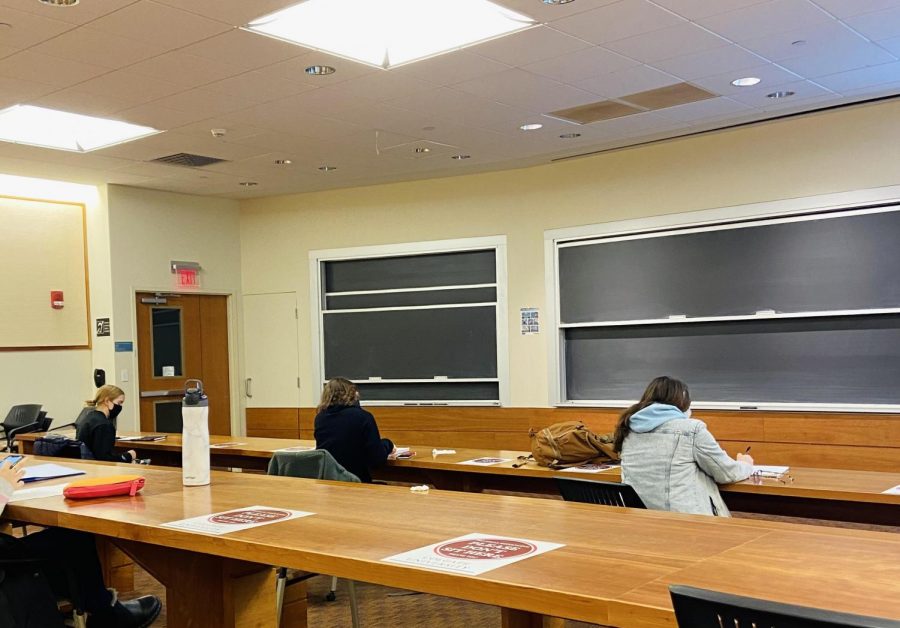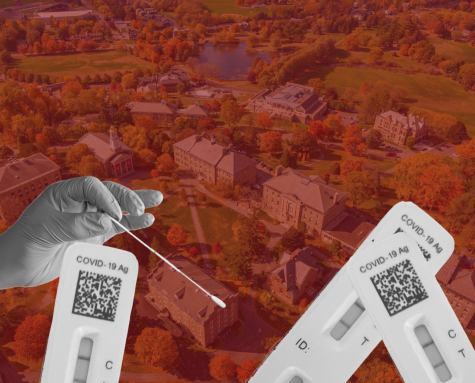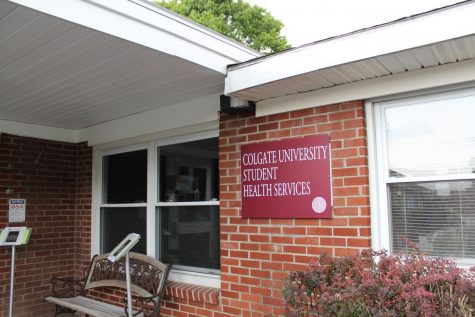Colgate Enters Gate 2 Despite Winter Storm Delaying Test Results
Despite significant delays in surveillance test results caused by winter storms, Colgate entered Gate 2 on Feb. 19 at 7 a.m., enabling larger group gatherings of 10 people and visitation in common spaces of other residence halls.
Vice President for Communications Laura Jack explained in her ‘Daily Digest’ newsletter sent on Feb. 17 that poor weather slowed hundreds of COVID-19 test kits from surveillance tests taken between Feb. 12 and Feb. 16 on their way to testing labs in Tennessee. Without these results, Colgate could not progress to Gate 2.
“To avoid compounding the test-delay problem, we will use rapid antigen tests tomorrow [Feb. 18] and Friday [Feb. 19],” Jack wrote in the email. “They are not as sensitive and require a follow-up for any positive results, but this stop-gap measure will help keep us moving and see some data.”
During the time the testing results were delayed, waste-water testing yielded positive results in four upper-campus waste lines. Associate Professor of Biology Geoffrey Holm emphasized that a single measurement cannot differentiate between a student currently infected with COVID-19 and one who was previously infected and no longer contagious but still shedding RNA.
“The positive results are certainly due to SARS-CoV-2 in the wastewater; it could be from a student residing in the building, a staff member using the restroom in the building, or a visitor from another dorm — which is only a possibility now that we are in Gate 2 unless people were violating the Commitment to Community Health,” Holm said.
Jack updated the community on Feb. 18 that positive levels of COVID-19 in wastewater had decreased in more recent tests and there were no positive results from 749 rapid tests. Dean of the College Paul McLoughlin said that even though the original tests were still delayed in weather, the rapid test results and wastewater monitoring provided enough information for the University to move to Gate 2.
“Yes, we would like to have had the remainder of the test results from Friday to Tuesday; however, the Wednesday and Thursday test results, combined with the wastewater results, were enough of a proxy that the Health Analytics Team [felt] confident enough in recommending movement to President Casey,” McLoughlin said.
Sophomore Charlie Quill said he felt concerned when he initially heard about the results of the wastewater test.
“The wastewater results were definitely an added concern at first, but since we heard back pretty quickly about the rates going down, it wasn’t a worry for too long,” Quill said.
First-year Jesse Harris echoed this sentiment.
“I initially felt a sense of worry. However, as I continued to read the email, my stress died down a little. I learned that it is possible for people that have returned from isolation to continue to shed final RNA and produce positive results,” Harris said.
The Health Analytics Dashboard shows that COVID-19 levels in wastewater are at low alert and remaining the same, as of March 1. The Health Analytics Team (HAT) will continue to monitor the waste stream from buildings on campus, as well as those in the Village of Hamilton, according to Holm.
In addition to wastewater and testing results, the number of available hospital beds in Community Memorial Hospital is a variable the HAT considered before recommending Gate 2, according to President Brian Casey.
“There were ICU patients in Madison County hospital that were not being cleared to move up to Syracuse,” Casey said.
According to the Health Analytics Dashboard, Community Memorial Hospital is currently at moderate alert and trending towards decreasing alert as of March 1.
Associate Vice President for Campus Safety Dan Gough stated that the number of Commitment to Community Health violations has decreased since moving to Gate 2. Gough also clarified Campus Safety’s approach to reports regarding Commitment Violations.
“Campus Safety takes an educational approach when responding to these reports, making sure that they explain the Commitment to Community Health provisions and the potential infection control risks when these provisions are not followed by all campus community members,” Gough said.
Quill spoke on what he feels is the general sentiment surrounding the Commitment to Community Health during the Spring 2021 semester as compared to last semester.
“Things seem a bit more relaxed this semester since most students have been through the whole process and experienced Gate 4. I think that sentiment might be slightly premature, but the testing rates have been really impressive this semester so it’s justified,” Quill said.
Casey said that the decision to move gates is complicated because his priority is safety.
“I have to protect the village. It’s easy to forget that but I have an older population, a vulnerable population, so I have to protect them too,” Casey said.










